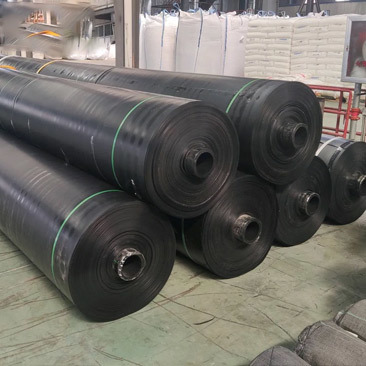Top 5 Applications of PE Geomembrane in the Construction Industry
Release time:
2025-10-10
Top 5 Applications of PE Geomembrane in the Construction Industry Introduction to PE Geomembrane The construction industry is continually evolving, with an increasing focus on efficiency, sustainability, and cost-effectiveness. One material that stands out in contemporary construction practices is the **Polyethylene (PE) geomembrane**. This synthetic membrane has become a pivotal component in vari
Top 5 Applications of PE Geomembrane in the Construction Industry
Introduction to PE Geomembrane
The construction industry is continually evolving, with an increasing focus on efficiency, sustainability, and cost-effectiveness. One material that stands out in contemporary construction practices is the **Polyethylene (PE) geomembrane**. This synthetic membrane has become a pivotal component in various applications, offering remarkable properties such as durability, impermeability, and resistance to environmental factors. In this article, we will delve into the **top five applications of PE geomembrane** in the construction industry, highlighting its critical role in enhancing project outcomes.
1. Landfill Liners: A Vital Component for Waste Management
The Need for Effective Waste Containment
Landfills are essential for managing waste, but they also pose significant environmental challenges. **Contaminants** can leach from landfill sites into the surrounding soil and groundwater, leading to pollution and health hazards. Thus, effective containment measures are critical.
PE Geomembrane as a Landfill Liner
PE geomembranes serve as an excellent barrier in landfill applications. Their **impermeability** prevents leachate from escaping, safeguarding the environment. The seamless installation of PE geomembranes minimizes the risk of leaks, ensuring that hazardous materials remain contained.
Benefits of Using PE Geomembranes in Landfills
- **Durability**: PE geomembranes resist punctures and tears, ensuring long-term effectiveness.
- **Cost-Effectiveness**: Their lightweight nature simplifies transportation and installation, reducing overall project costs.
- **Environmental Protection**: By preventing leakage, they play a crucial role in protecting groundwater quality.
2. Water Reservoirs: Enhancing Water Storage Solutions
The Importance of Reliable Water Containment
Water reservoirs are critical for agricultural, municipal, and industrial applications. However, the risk of water loss due to seepage can significantly impact their efficiency. Ensuring **water containment** is crucial for maximizing the utility of these reservoirs.
PE Geomembrane in Water Reservoir Construction
Utilization of PE geomembranes in water reservoirs provides a reliable solution for **seepage control**. When lined with a PE geomembrane, reservoirs exhibit reduced water loss, ensuring that the stored water remains available for its intended use.
Advantages of PE Geomembranes in Reservoirs
- **Water Quality Maintenance**: The non-toxic nature of PE geomembranes ensures that there is no leaching of harmful substances into the water.
- **Cost Efficiency**: The installation process is straightforward, leading to reduced labor costs and quicker project timelines.
- **Flexibility**: PE geomembranes can be customized to fit various reservoir shapes and sizes, providing versatile solutions.
3. Pond Liners: Protecting Ecosystems and Aesthetics
The Role of Pond Liners in Environmental Preservation
Ponds are integral to many landscapes, providing habitats for wildlife and aesthetic value to properties. However, maintaining the quality of pond water can be challenging without proper containment measures.
Using PE Geomembranes as Pond Liners
PE geomembranes are commonly used as pond liners due to their **impermeable** qualities. They effectively prevent water from leaking into the ground, maintaining the pond's water level and quality.
Benefits of PE Geomembranes in Pond Applications
- **Environmental Benefits**: Protects local ecosystems by preventing contamination from surrounding areas.
- **Maintenance Cost Reduction**: Reduces the need for frequent refilling and maintenance, leading to long-term savings.
- **Aesthetic Preservation**: Maintains the clarity and quality of pond water, enhancing the visual appeal of landscapes.
4. Mining Applications: Safeguarding Resources and the Environment
The Necessity for Environmental Compliance in Mining
Mining operations can lead to significant environmental challenges, including contamination of soil and water. Compliance with environmental regulations is mandatory for sustainable mining practices.
PE Geomembranes in Mining Operations
In mining, PE geomembranes are employed for **tailings containment** and **leachate collection** systems. Their robust impermeable nature ensures that hazardous materials do not escape, thereby protecting the surrounding environment.
Advantages of PE Geomembranes in Mining
- **Regulatory Compliance**: Helps mining companies meet stringent environmental regulations.
- **Enhanced Safety**: By containing hazardous materials, PE geomembranes enhance the safety of mining operations.
- **Cost-Effectiveness**: Reduces the need for extensive remediation efforts due to leaks or spills.
5. Agricultural Applications: Improving Irrigation and Soil Conservation
The Importance of Efficient Water Management in Agriculture
In agriculture, efficient water management is vital for crop productivity and sustainability. **Inefficient irrigation systems** can lead to water wastage and soil erosion.
PE Geomembranes in Agricultural Practices
PE geomembranes are increasingly used in agricultural applications to line irrigation channels and ponds. This prevents water loss through seepage, ensuring that more water reaches crops.
Benefits of PE Geomembranes in Agriculture
- **Water Conservation**: Significantly reduces water wastage, promoting efficient water usage.
- **Soil Protection**: Minimizes soil erosion by maintaining water levels in irrigation channels.
- **Cost Efficiency**: Lowers the overall costs associated with irrigation systems by reducing the need for extensive water resources.
Conclusion
PE geomembranes have emerged as essential components in the construction industry, offering versatile applications across various sectors, including waste management, water conservation, mining, and agriculture. Their remarkable properties, such as durability, impermeability, and cost-effectiveness, make them invaluable for modern construction practices. As the industry continues to embrace sustainability and innovation, the role of PE geomembranes is likely to expand, contributing to more efficient and environmentally friendly construction solutions.
FAQs
1. What are the primary materials used in PE geomembranes?
PE geomembranes are primarily made from high-density polyethylene (HDPE) or linear low-density polyethylene (LLDPE), ensuring durability and impermeability.
2. How long do PE geomembranes last?
With proper installation and maintenance, PE geomembranes can last for over 30 years, making them a long-term solution for containment applications.
3. Can PE geomembranes be recycled?
Yes, PE geomembranes can be recycled, and many manufacturers are implementing recycling programs to promote sustainability.
4. Are PE geomembranes safe for agricultural use?
Absolutely! PE geomembranes are non-toxic and do not leach harmful substances into the soil or water, making them safe for agricultural applications.
5. How are PE geomembranes installed?
Installation typically involves site preparation, cutting the geomembrane to size, and securing it in place using various methods, such as welding or anchoring. Professional installation is recommended for optimal results.
Previous Page






